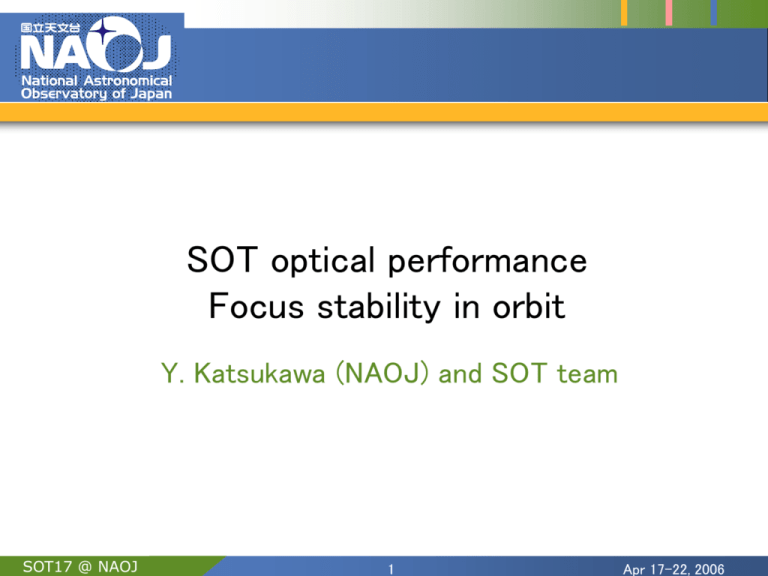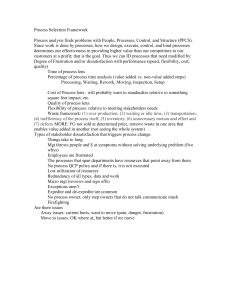sot17_focus_060417
advertisement

SOT optical performance Focus stability in orbit Y. Katsukawa (NAOJ) and SOT team SOT17 @ NAOJ 1 Apr 17-22, 2006 SOT focus design OTA is designed to provide collimated beam into FPP in air, and provides a weakly converging beam (f200m) in vacuum. Air-to-vacuum difference of the focus position of OTA and FPP are adjusted by initial setting of the “re-imaging lens” position. The 4 optical paths (BFI, NFI, SP, and CT) are designed to be kept in cofocal without any focus adjustment. Apr 17-22, 2006 SOT17 @ NAOJ 2 Focus adjustment by the re-imaging lens Focus shift originating in OTA and FPP can be compensated by movement of the re-imaging lens along the optical axis during the mission operation. We plan to adjust the focus position occasionally to compensate seasonal variation. No need to adjust the position within one orbital cycle because orbital variation is supposed to be negligible. Mechanisms for the motion of the re-imaging lens have the specifications shown below. Specifications Stroke range 25 mm Resolution 0.17mm /step Reimaging lens M2 M1 Apr 17-22, 2006 SOT17 @ NAOJ 3 Focus shift in orbit Focus shift is caused by displacement of optical elements along the optical axis. The change of M1-M2 distance is most sensitive to the focus shift. Mechanical environmental (vibration and acoustic) tests showed no significant change in focus position. The thermal environment in orbit is very different from that on the ground. In order to predict the focus shift in orbit, we performed thermal-optical test of the telescope, and determined the defocus sensitivity for major components experimentally. Focus errors (including margins) are controlled by a focus error budget table. The focus position is confirmed to be well within adjustable range by the reimaging lens for the mission period. Apr 17-22, 2006 SOT17 @ NAOJ 4 Focus position in the first light phase After the telescope top-door is opened, the temperatures inside the telescope increase, and are settled within several hours. The telescope main structure is made of CFRP (carbon fiber reinforced plastic). The dehydration of CFRP makes M1-M2 distance smaller in vacuum. The speed of the shrinkage is temperature dependent. Focus pos (mm) Just after door opening OTA FPP Focus pos (mm) 1 month (?) later CFRP dehydration 0 -4.2 (0.8) Temperature change -2.5 -2.5 Initial offset (-2.3) +12.0 +12.0 (CLU air-vac. diff) (+4.7) (+4.7) 0 0 (+1.0) (+1.0) +8.6 +4.5 Initial offset (reimaging lens air-vac. diff) Total Apr 17-22, 2006 SOT17 @ NAOJ 5 Focus shift by CFRP dehydration Just after launch 0mm Apr 17-22, 2006 1 month (?) later M2 M2 M1 M1 -8.3mm -4.2mm SOT17 @ NAOJ 6 2nd test on May 2004 OTA temperature was kept 20C during the test. Time constant 400hrs A20 (lambda, DP) Temperature dependence of CFRP dehydration Time (hour) 4th test on Mar 2005 Focus position did not change during the cold mode. Apr 17-22, 2006 Cold mode SOT17 @ NAOJ Hot mode Time (hour) 7 Orbital variation by temperature ripple The temperature prediction in orbit tells that there is 1-2C temperature ripple within one orbital cycle especially around M2. The focus shift within one orbital cycle is expected to be around 0.2mm at the reimaging lens focus. This corresponds to one or two steps of the focus adjustment, and is within focal depth. Temperature and focus ripple within one orbital cycle (Only major components are shown in the table.) M1-M2 sensitivity (m/ C) Temperature ripple T (C) M2 support -0.05 2.3 HDM spider -0.61 0.9 Ring plate 0.59 0.8 Top ring 0.15 2.0 Upper truss -0.11 1.1 Lower truss -0.13 0.2 M1 support -1.06 0.1 Focus pos at reimaging lens (mm) Apr 17-22, 2006 SOT17 @ NAOJ 0.22 8 Focus change between DC and Limb obs. In limb observations, heat inputs to the telescope become smaller than those in DC obs. This makes the temperatures 1 - 2 C lower. This temperature change causes small focus shift, but the shift is expected to be about 0.1mm, and is negligible. Temperature and focus change between DC and Limb obs. (Only major components are shown in the table.) Temperature (C) @ BOL M1-M2 sensitivity (m/ C) Disk center Limb M2 support -0.05 -4.5 -6.2 HDM spider -0.61 -25.1 -26.9 Ring plate 0.59 -28.0 -29.5 Top ring 0.15 -27.7 -29.0 Upper truss -0.11 -23.6 -25.3 Lower truss -0.13 -0.5 -0.9 M1 support -1.06 10.4 9.6 -2.51 -2.39 Focus pos at reimaging lens (mm) Apr 17-22, 2006 SOT17 @ NAOJ 9 Long-term focus shift Because of the contamination on the mirror surface, the temperature inside the telescope tends to increase gradually through the mission life. The temperature increase causes gradual focus shift, and will be compensated by the re-imaging lens. Temperature and focus change through the mission life (Only major components are shown in the table.) Temperature (C) @ DC obs. M1-M2 sensitivity (m/ C) Beginning of life End of life M2 support -0.05 -4.5 11.5 HDM spider -0.61 -25.1 0.6 Ring plate 0.59 -28.0 -1.1 Top ring 0.15 -27.7 -1.2 Upper truss -0.11 -23.6 1.4 Lower truss -0.13 -0.5 18.7 M1 support -1.06 10.4 27.3 -2.51 -3.78 Focus pos at reimaging lens (mm) Apr 17-22, 2006 SOT17 @ NAOJ 10 Summary The orbital and DC-Limb variation are expected to be 12 steps of the focus adjustment, and well within focal depth. We should verify orbital and DC-Limb variation in the first light phase. The seasonal and long-term focus shift will be compensated by occasional adjustment of the re-imaging lens position. Apr 17-22, 2006 SOT17 @ NAOJ 11







